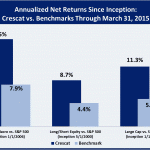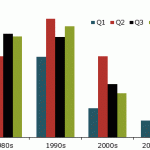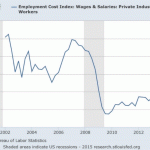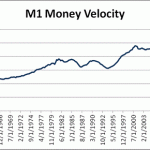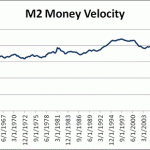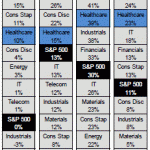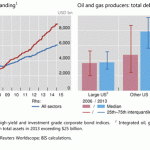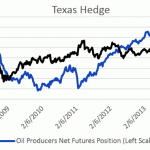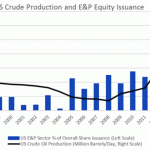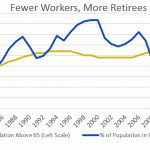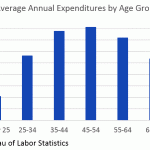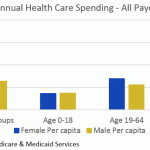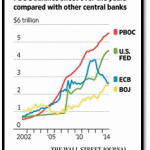Crescat Capital Quarterly Investor Letter Q2 2015
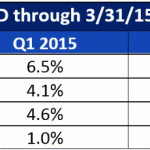
June 12, 2015
Crescat Capital Quarterly Investor Letter Q2 2015
Performance Update
We are pleased to report that the Crescat Global Macro Fund was recently named one of the top-ten performing global macro hedge funds by BarclayHedge for the three years ended 3/31/2015. As shown in the table below, all three Crescat strategies performed strongly in Q1 while the S&P 500 Index gained just 1%.
Global Macro, Long/Short, and Large Cap with 9-year, 15-year, and 16-year track records respectively, have all substantially exceeded the S&P 500 net of fees since inception. Annualized results through Q1 are shown below.
Performance reports showing absolute and risk-adjusted returns may be downloaded in these links:
Crescat Global Macro – Crescat Long/Short – Crescat Large Cap
Year-to-date net performance estimates through May 31, 2015 are as follows: Global Macro +5.9%, Long/Short +4.1%, and Large Cap +5.7%, S&P 500 +3.2%.
Investment Outlook
At Crescat, we organize our portfolios and our investment letters around our top-down, macroeconomic themes. Having a set of diversified, non-correlated macro themes has been a key driver of Crescat’s strong risk-adjusted performance over the years.
Fed Lift Off
Fed Moderation (aka Fed Lift Off) is a recent theme that has been working well, particularly as it relates to our fixed income short positons in the Global Macro Fund.
Fed Chair Janet Yellen, Vice Chair Stanley Fischer, and other Fed officials have been preparing the markets for likely interest rate increases starting later this year.
When it comes to the Fed raising interest rates, we see three possible main risks in the US today:
- The economy is not strong enough to handle a rate increase and slips back into recession
- A rate increase creates too strong of a dollar which reverses recent improvement in the trade deficit and hurts economic growth
- A rate increase triggers a correction in asset price bubbles in the bond and/or stock markets
Many market participants are skeptical that the data-dependent Fed will actually raise rates. Regarding the economy not being strong enough to handle rate hikes, the recent slowdown in Q1 real GDP growth which initially came out at +0.2% and that was revised down to -0.7% at the end of last month, is a concern to many market participants. We think the Q1 GDP report is not representative of the true strength underlying US economy for several reasons:
Extreme bad weather in Q1 and the West Coast port strike;
Sector specific problems in energy that are actually bullish for the overall economy;
Most importantly, there is a material error in Q1 seasonal adjustment factor used by the Bureau of Economic Analysis that incorrectly penalized Q1 GDP according to the San Francisco Fed.
Source: Federal Reserve Bank of San Francisco
The chart above shows average year-over-year reported real GDP growth for each of the last four decades. It clearly shows the downward error in BEA’s Q1 seasonal adjustment that has crept in over the last two decades.
The Fed’s researchers concluded that “there is a good chance that underlying economic growth so far this year was substantially stronger than reported”. The BEA acknowledges the error, but is not likely to fix it until the first estimate of Q2 GDP comes out in late July.
Another risk of raising rates is that the Fed creates too strong of a dollar, particularly as other major world economies remain in QE mode. In this case, a too-strong dollar could hurt US exports and worsen the trade deficit. We would note that the trade deficit has not materially worsened since the dollar began rallying in September of last year. The silver lining here has been the offsetting impact on imports in the U.S. from lower oil prices. We continue to believe that oil prices will stay depressed as we discuss below.
For now, we are in the camp that believes that the Fed is still likely to begin lifting the Fed Funds rate in September. The biggest risk going into the Fed rate hike cycle is that the Fed’s zero interest rate policy (ZIRP) has created asset-price bubbles in both the bond and the stock markets. The Fed needs to be ahead of the curve if it wants to prevent asset bubbles from becoming too far-reaching in the overall economy. Egregious assets bubbles can lead to recessions when they ultimately burst. Such was the case with the tech and housing bubbles in the US. There is risk that the Fed is already behind the curve in raising interest rates. With the strong improvement in the employment picture, and wage inflation pressures likely showing up soon, we believe the Fed will soon be encouraged to move.
Such is where we are in the economic cycle. The Fed is getting ready to raise interest rates. It has been a long slow recovery in the wake of the Global Financial Crisis. While many market participants are fearful that we have reached the end of an expansionary cycle, we think that a possibly bigger risk is that we are reaching an inflection point in the economy where both growth and inflation are likely to accelerate. Many players in the financial markets are not ready. The bond market is particularly at risk. Bond market investors may be too complacent after a record 34-year bull market. Many are not prepared for rising economic growth, rising inflation, and rising interest rates. In this view, among all US asset bubbles, we believe it is that of the bond market that is the largest.
The Fed wants to create inflation to ease the burden of debtors and to deleverage the overall debt-to-GDP in the economy. Inflation helps reach the Fed’s goal of full employment. Inflation is a key component of our Debt-to-GDP Resolution theme that we believe must ultimately play out in high-debt-to GDP developed economies like the UK, Europe, Japan, and the US. The problem is that the actual timing of the inflation that follows quantitative easing is subject to lags and its magnitude is uncertain. It has been a big surprise to us that we have not seen more inflation to date in the US. There are two main reasons for the lag:
- Lack of significant M2 credit expansion, the drag from the banking sector
- Persistently declining money velocity, the lag in expectations
US banks are still sitting on $2.5 trillion in excess reserves. This is the new M0 money supply (monetary base) that was created as a result of QE1, QE2, and QE3, but it has only turned into modest overall M1 and M2 money supply growth to date because of both banks’ hesitancy to lend and borrowers’ hesitancy to borrow. Money supply growth, i.e., credit expansion through our fractional reserve banking system, is a key driver of overall nominal GDP growth necessary to get the economy growing strong again and to stir up inflationary forces.
Source: Bloomberg
Another key driver of nominal GDP growth is money velocity. As we show above, the biggest problem is that M1 money velocity has been in a downward trend since 2007. M2 Money Velocity has been in a downtrend since the late 1990s. Money velocity is the frequency at which the money supply turns over in the economy for the purchase of new domestically-produced goods and services. It can be thought of as the productivity of credit in producing goods and services. Money velocity is the multiplier effect on top of M1 and M2 in creating GDP. Conceptually, money velocity can be thought of as a backward-looking measure of overall economic participants’ optimism versus pessimism as well as their inflationary versus deflationary expectations. It measures the pace at which its participants have been putting their money to work to engage in economic activity such as consumption, investment, government spending, and net exports.
Money velocity today reflects a still overwhelmingly deflationary consciousness among economic participants. ZIRP has not been working to change the deflationary consciousness. The Fed may simply be changing its game plan because it wants people to increase their inflationary expectations in order to help get the economy moving again. We cannot have escape velocity in the economy at large and escape from ZIRP if we continue to have declining money velocity. In this sense, ZIRP may be exerting a deflationary gravitational pull and the Fed is trying to turn it around. An upward swing in economic and inflationary expectations are of particular risk to the bond market. The still overwhelming deflationary consciousness further supports our view that bonds are a crowded trade. When inflation expectations shift from deflationary to inflationary, inflation and economic growth, as measured by GDP, become self-fulfilling. This is a mixed blessing for stocks at today’s valuations, but is unambiguously bad for bonds.
In our Global Macro hedge fund, Crescat has a variety of short positions across the maturity and credit quality spectrum of the fixed income curve as a part of our Fed Moderation Theme to hedge against risks and capitalize on the opportunities from rising interest rates. We think it’s a low-risk, high-reward trade to be on the other side of long duration Treasuries and junk bonds, in particular. Shorts in highly leveraged companies with bad business models at risk of credit downgrade and rising cost of debt financings also fit into this theme. These companies also score poorly in our valuation model. In our hedge funds we have also been short Hertz (HTZ), utilities (XLU), and Vanguard REIT ETF (VNQ) as part of this theme.
U.S Banking Resurgence
Conventional wisdom holds that banks will become more profitable in a rising interest rate market due to improving net interest margins. According to a study by the Chicago Federal Reserve, rising interest rates indeed improve bank net interest margins, but in and of itself, it is a minor factor driving improvement in the banking industry. The Fed paper shows that what matters most for increased bank profitability is a strong overall economy. The Fed shows that factors like declining unemployment rate, rising home prices, and rising real GDP having the biggest impact on driving improved bank profitability. The next few years could be a great time to own US banks, which we do in all of our strategies, given their attractive valuations today combined with the possibility of an upward inflecting economy. The latter is not priced in today and would take many by surprise. In our view, with banks holding $2.5 trillion in excess reserves, the employment picture improving, home prices heating up again, and real growth better than most acknowledge due to the factors we discussed above, the potential for both new lending growth and an improving macro economy are bright. New lending growth drives both bank profitability and an improved economy at the same time. The two feed on each other in our fractional reserve banking system where banks can multiply reserve money in turn driving GDP growth. If, in turn, we increased expectation or positive economic growth and inflation and hence upward turning money velocity, indeed we could see a very positive inflection in US real and nominal economic growth that would be a major tailwind for banks. Financials furthermore score well as a macro aggregation in our fundamental equity model among GICS sectors.
Biotech Bubble
While our Nanoscale theme was a big winner for us for more than a year, at the beginning of the year, we became concerned that valuations in far too many biotechnology companies have become excessive. For us, the Nanoscale theme was about scientific advances in biology and genetics that offered exciting new therapies for human health and fighting disease. We owned several leading RNAi technology biotech companies as a way to participate in this theme and we did well with this theme in 2013 and 2014. But we have changed our mind about the wisdom of investing in such emerging growth stocks at this time. Investing in biotech today seems a bit like investing in dotcom stocks in early 2000. Nonetheless, if this bubble were to burst, we do not believe it would be as much overall risk to economy as it was with the tech and housing bubbles.
We have initiated a new theme, Biotech Bubble.
The S&P Biotechnology Select Industry Index has returned 364% over the five years ended in May 2015 while the S&P 500 delivered 127%.
In aggregate, this index trades at record levels based on a combination of valuation factors: 8 times book value, 16 times sales, 228 times earnings, negative 4% free cash flow yield, and a .02% dividend yield.
It was almost a year ago when Janet Yellen said that “valuation metrics in some sectors do appear substantially stretched-particularly those for smaller firms in the social media and biotechnology industries”
Valuation metrics for biotechs have become substantially more stretched since then.
Last month the Fed Chairwoman warned “I would highlight that equity market valuations at this point generally are quite high…there are potential dangers there.”
Earlier this year, Credit Suisse carved out the biotechnology industry as if it were its own sector in order to perform a cross sectional analysis relative to other GICS sectors. In that analysis, the biotech group proved to be the only sector that has ever outperformed all the other sector for four calendar years straight. Through the first five months of 2015 it is the leading group again, up 28% year to date.
Source: Credit Suisse
We believe that biotechs are at high risk for a significant correction this year. In our hedge funds, we are shorting the SPDR S&P Biotech ETF (XBI) to get exposure to this theme. XBI is and equal weighted, as opposed to a market cap weighted, ETF with 97 holdings. We are partially hedged with a long position in Gilead Sciences (GILD). GILD scores high in our fundamental model. Most biotech stocks score low in our model. Many of those are in XBI. There is the possibility that XBI is making a bearish triple-top at its current level.
The reason that Janet Yellen has been warning about stretched valuations in biotech and social media private equity is that she is trying to prepare the market for interest rate increases. Most publicly-traded biotech stocks (GILD is an exception) are like long-duration zero-coupon junk bonds, securities whose cash flows come far out in the future if at all. Chair Yellen is warning about the wisdom of owning these richly valued, high duration, high-risk assets in the face of a Fed rate-hike cycle. In other words, the risk of price correction due to Fed lift off in frothy emerging growth segments of the markets is high. The catalyst for the price correction is the Fed’s interest rate increases. To drive the point home, we would argue that the catalyst that popped the tech bubble was the Greenspan Fed’s rate hikes in the first six months of 2000.
Oil Prices Staying Low
Despite other inflationary pressures building in the economy, we believe that oil prices will generally stay depressed based on oil’s supply and demand fundamentals. Short opportunities continue among oil and gas exploration stocks. We discussed our anticipation of this move and successful oil-related short positions to date in our last two quarterly letters.
While many attribute the increase in US production to advances in hydraulic fracturing, perhaps the biggest reason for the oil and gas supply boom has been the easy money available to producers via the equity and debt markets. Low interest rates, oil in the ground as collateral, and general bullish oil sentiment encouraged oil and gas companies to issue billions in debt since the beginning of the shale boom. Much of this debt was issued by smaller US producers and by state owned companies in emerging economies (EME in the graph below, includes Brazil, Russia, and others), while large US producers remained more conservative.
Energy debt issuances accelerated along with the shale boom and far surpassed the pace of the market at-large. New debt will be expensive because the value of the oil companies’ collateral along with the present value of their future cash flows has decreased significantly along with the price of oil. These companies must continue to produce in order to service their heavy debt burdens. Continued production will keep downward pressure on prices. This is the same problem that has already been playing out on the natural gas side of the business for the exploration and production companies over the last seven years.
Oil producers are the natural hedgers in the oil market. If they were doing it correctly, they would have hedged their future production when oil prices were higher by shorting oil futures. However, as Commodities Futures Trading Commission data shows, oil producers collectively had net long positions in the futures markets in 2013 and 2014 before prices collapsed. That is what we call a “Texas hedge”, a position that increases rather than reduces risk. Texas hedging would be OK if management and shareholders understood the risk and management was on the right side of the trade, but that was not the case. Producers put hedges in tandem with the falling price exacerbating the price drop. Oil producers’ poor hedging track record is another reason we remain short their stocks.
E&P companies have continued debt and equity offerings, diluting existing shareholders and offering new bonds senior to outstanding issues. These cash raises are necessary to keep the oil flowing. Below we show US crude oil production and equity issuance by E&P companies as a share of total equity issuance.
There is still a significant surplus of oil in world markets, which will not be alleviated by a slowing of US production growth, or even by a slight decrease in US production levels. Saudi Arabia is more worried about prolonged periods of high prices destructing demand for oil rather than periods of low prices straining their budget. Oil’s exhaustible nature means there is always upward pressure on its price in the long run, even if other forces prevail in the short run. Saudi Arabia is taking this opportunity to increase their market share to position themselves even better when oil prices eventually rebound.
Aging Population
Aging Population is a macro theme that has been around informally at Crescat for a while. We have recently begun developing the theme more concretely, associating investments with these significant demographic shifts. Baby Boomers continue to age, contributing to the demographic shift in the US. The percent of the US population above 65 has been steadily increasing since the Baby Boomers entered that demographic 5-10 years ago. This has contributed to a lower percent of the population in the workforce, or fewer workers supporting a growing number of retirees. While the older portion of the population tends to spend less overall, they spend significantly more on health care, as we show in the graphs below.
The Aging Population theme is also relevant to our investments in Europe, Japan, and China that also have an aging demographic. This as a long-term secular theme. We are long select healthcare stocks and financials in the US as part of this theme. The healthcare stocks that we are long have strong valuations and are supported by our fundamental model. They serve as a hedge to our biotech shorts which are also supported by our model.
China Currency and Credit Bubble
We have written extensively already in the last two quarterly letters about the overvaluation of the Chinese yuan despite conventional wisdom to the contrary. The two key points supporting our thesis:
- Downward pressure on the currency from high levels of money printing and illicit capital outflows of approximately $8 trillion over the last 15 years.
- A domestic credit bubble evidenced by an M2 money supply that is 74% larger than the US despite an overall economy that is 58% smaller than the US in terms of GDP
According to our most recent update on this theme, China continues to stimulate its economy through unconventional forms of monetary policy in the form of aggressive quantitative easing. The People’s Bank of China (PBOC) has accumulated more assets in the last decade than any other major central bank:
News coming out of China regarding the true levels of its monetary stimulus is sparse. Nonetheless, here are some instances in US dollar equivalent levels that we have been able to discern:
- In April of 2015, the PBOC injected a total of $62 billion by purchasing equity stake into China Developed Bank and Export-Import Bank of China.
- In 2014, the largest state owned banks received about $242 billion in loans from the PBOC.
- Three interest rates cut in the last six months.
We believe it is important to acknowledge the aggressive monetary stimulus made by the Chinese Central Bank and take this opportunity to reevaluate our thoughts on Chinese equities. Many recent moves are actually bullish for Chinese equities. There have been crackdowns on capital outflows while the Chinese lobby for their inclusion in the International Monetary Fund’s Special Drawing Rights (SDR), a basket of the most stable and freely-traded currencies worldwide. Restrictions on margin accounts have been loosened significantly, and despite the economy and real estate markets slowing substantially, the Chinese continue to orchestrate a bull market in their domestic equities.
To the delight of the Chinese President Xi Jinping, this strategy seems to have created a wealth effect to Chinese investors. The number of new stock market accounts has tripled in 8 months. We believe the PBOC will continue to stimulate the economy in innovative ways, and this approach should support a bull market thesis for companies at reasonable valuations. As we mentioned before, the yuan is likely to suffer further downward pressure versus the dollar. With a massive amount of money printing simultaneously inflating stock prices and pushing the currency down, it is important to remain hedged against and ultimately positioned for a currency devaluation, which we are able to do in our Global Macro Fund.
In aggregate, the Shanghai composite currently trades at 21 times earnings, with a free cash flow yield of 2.6%, and a 2.5 price to book value. These broad market numbers are not overly attractive given our value investing approach, but there is value to be found. We have gotten long a small basket of Chinese stocks that score well in our fundamental model, but only in our Global Macro Fund where we have a significant short position in the currency. These holdings include Ali Baba (BABA), New Oriental Education (EDU), and NetEase (NTES). They have healthy balance sheets and an average forward free cash flow to enterprise value of 5.8%.
Please feel free to contact us at (303) 271-9997, or [email protected] for more information.
Sincerely,
The Crescat Investment Team
Kevin C. Smith, CFA
Chief Investment Officer
Only accredited investors and qualified clients will be admitted as limited partners to a Crescat fund. For natural persons, investors must meet SEC requirements including minimum annual income or net worth thresholds. Crescat funds are being offered in reliance on an exemption from the registration requirements of the Securities Act of 1933 and are not required to comply with specific disclosure requirements that apply to registration under the Securities Act. The SEC has not passed upon the merits of or given its approval to the Crescat funds, the terms of the offering, or the accuracy or completeness of any offering materials. A registration statement has not been filed for any Crescat fund with the SEC. Limited partner interests in the Crescat funds are subject to legal restrictions on transfer and resale. Investors should not assume they will be able to resell their securities. Investing in securities involves risk. Investors should be able to bear the loss of their investment. Investments in the Crescat funds are not subject to the protections of the Investment Company Act of 1940. Performance data represents past performance, and past performance does not guarantee future results. Performance data is subject to revision following each monthly reconciliation and annual audit. Current performance may be lower or higher than the performance data presented. Crescat is not required by law to follow any standard methodology when calculating and representing performance data. The performance of Crescat funds may not be directly comparable to the performance of other private or registered funds. Investors may obtain the most current performance data and private offering memorandum for a Crescat fund by contacting Linda Smith at (303) 271-9997 or by sending a request via email to [email protected]. See the private offering memorandum for each Crescat fund for complete information and risk factors.
Excerpt from –
Crescat Capital Quarterly Investor Letter Q2 2015
See which stocks are being affected by Social Media


